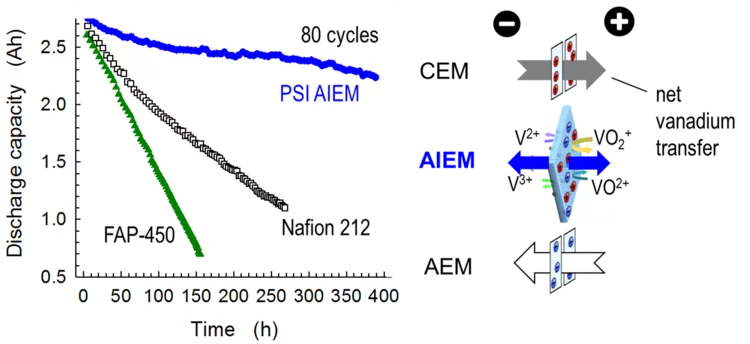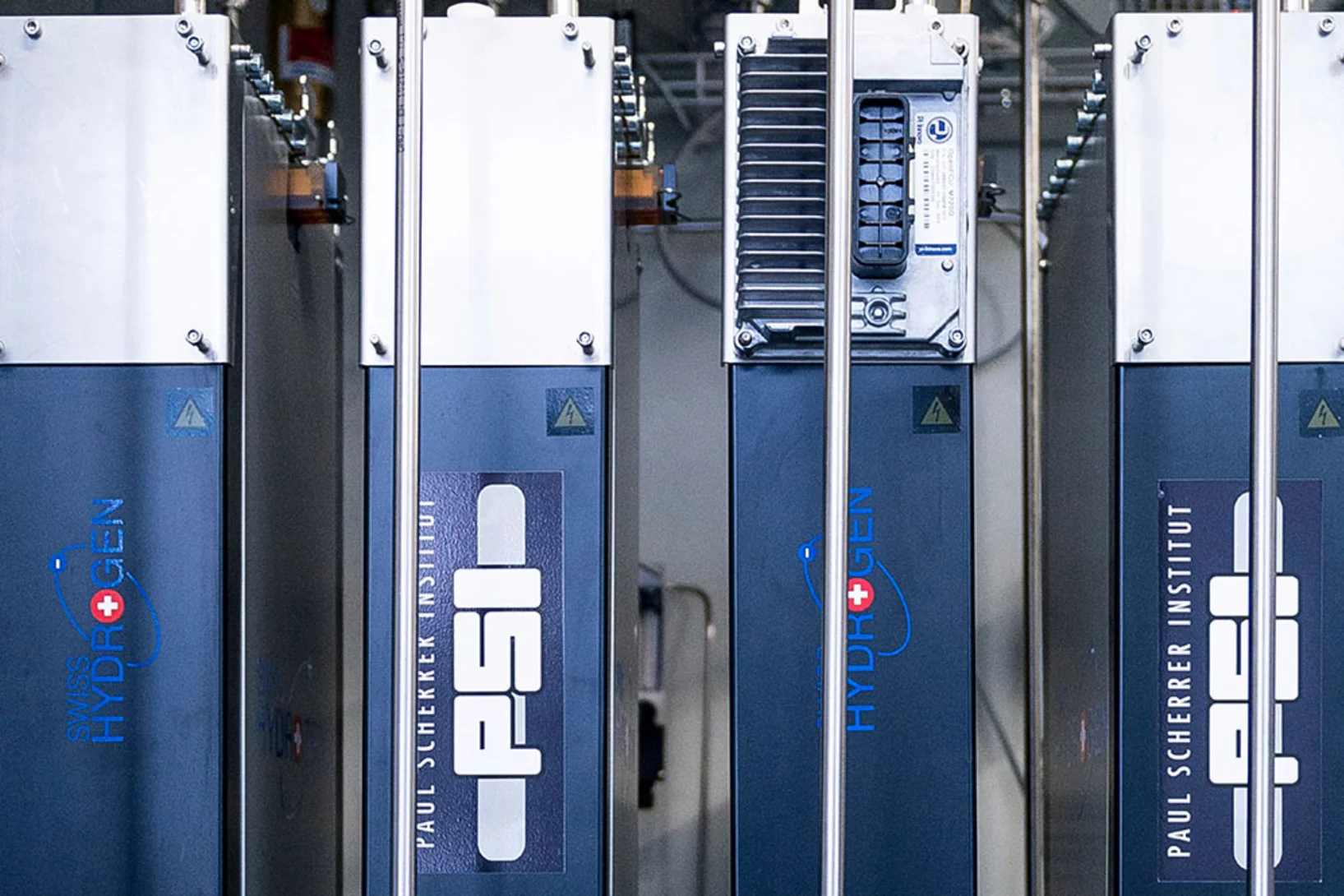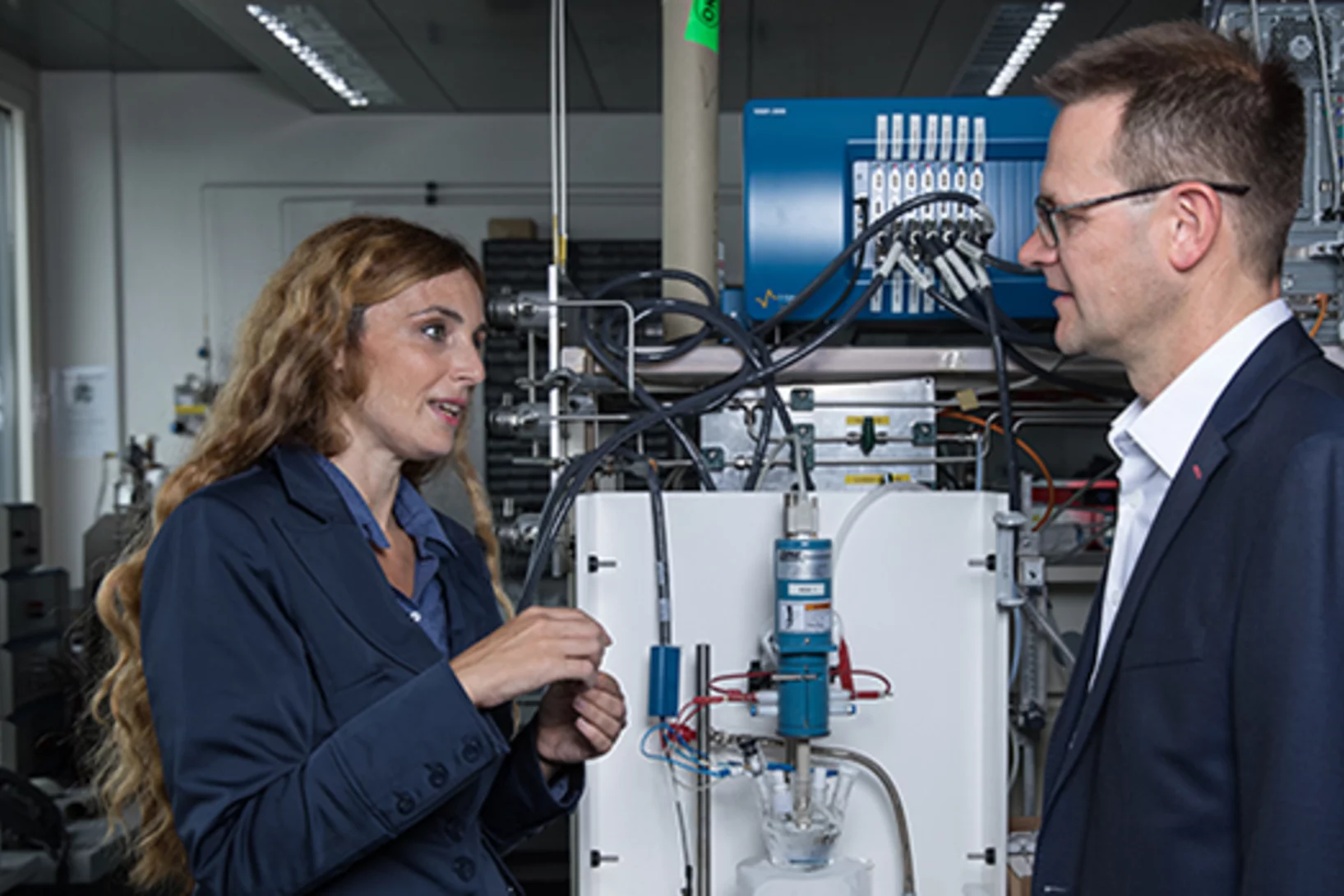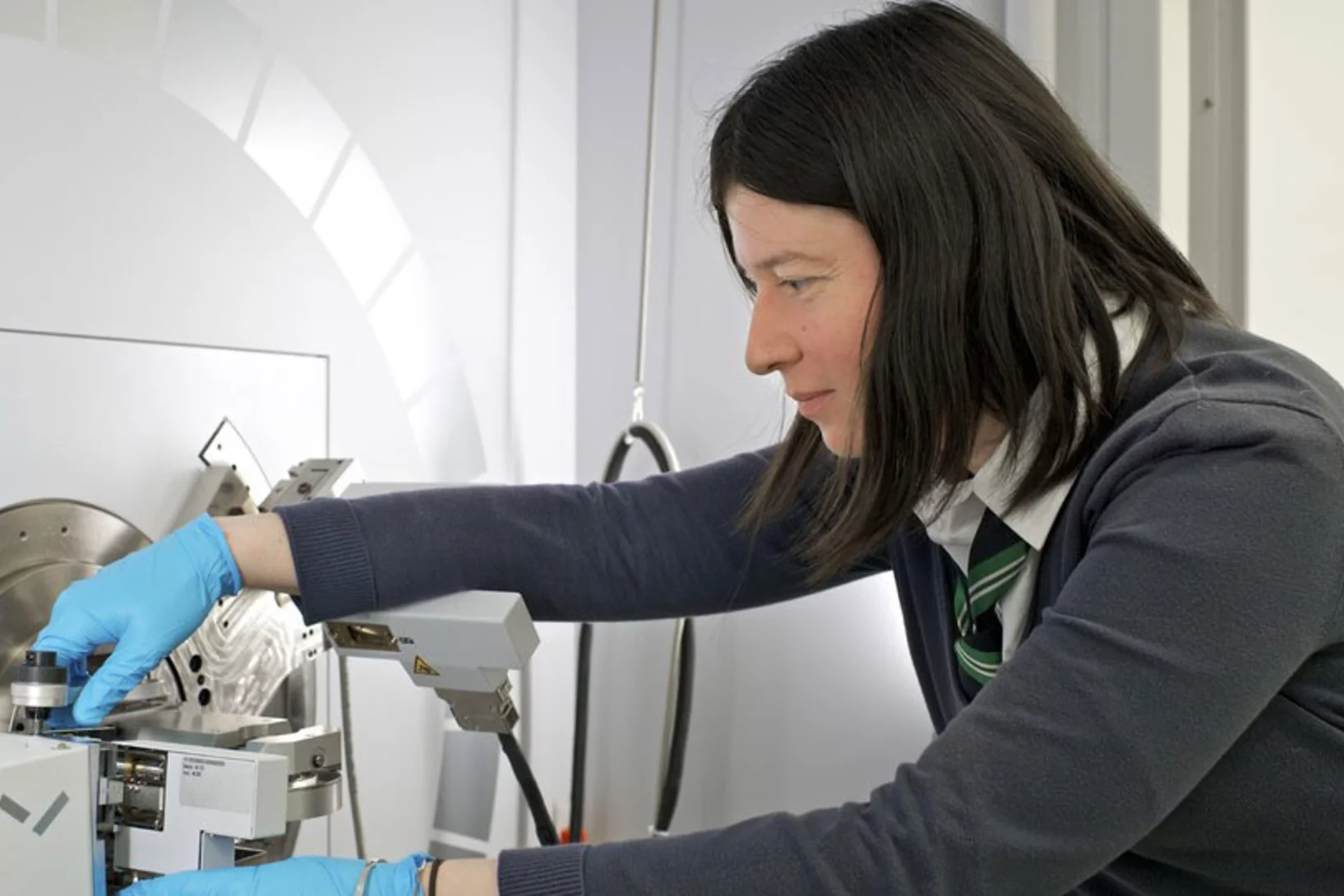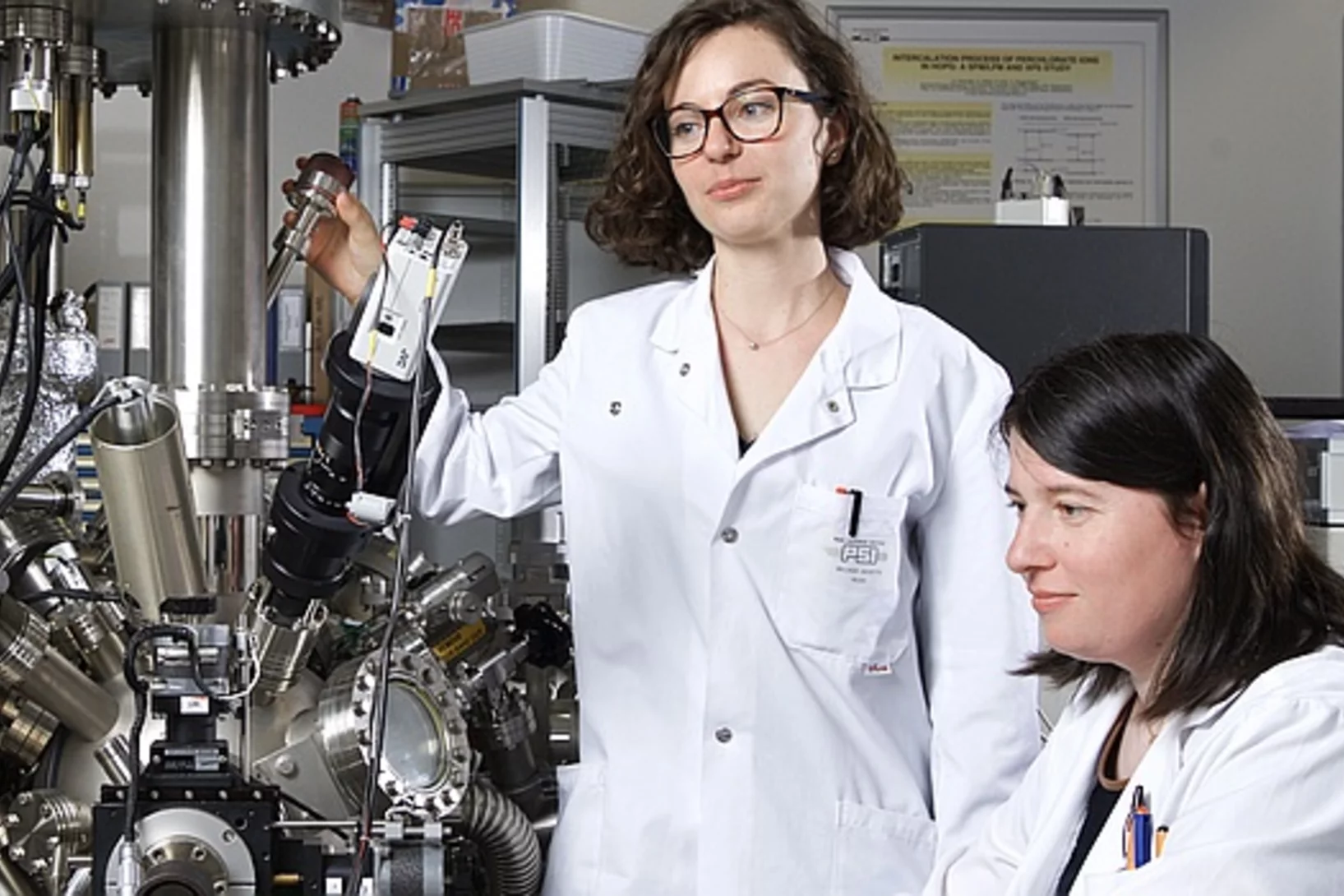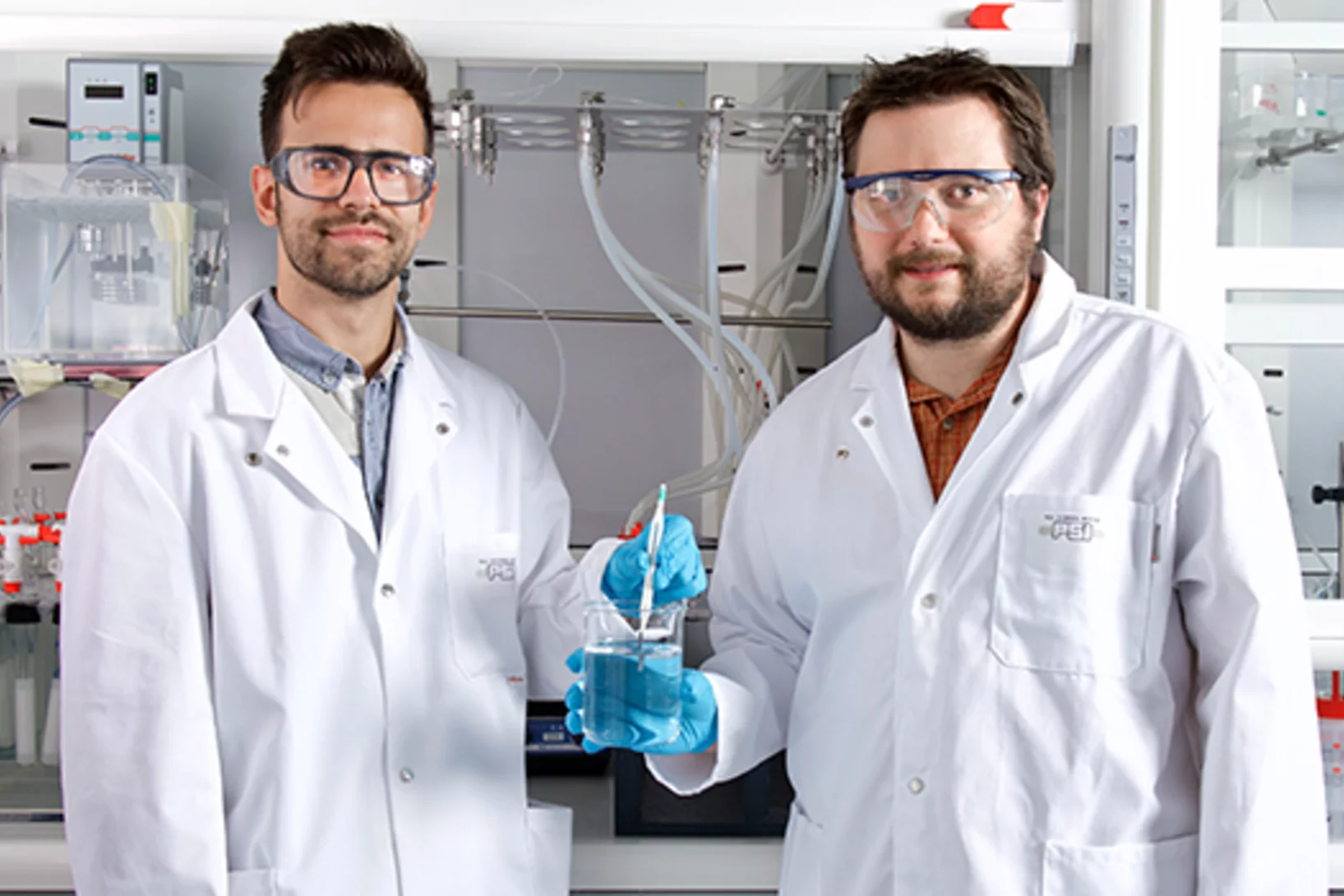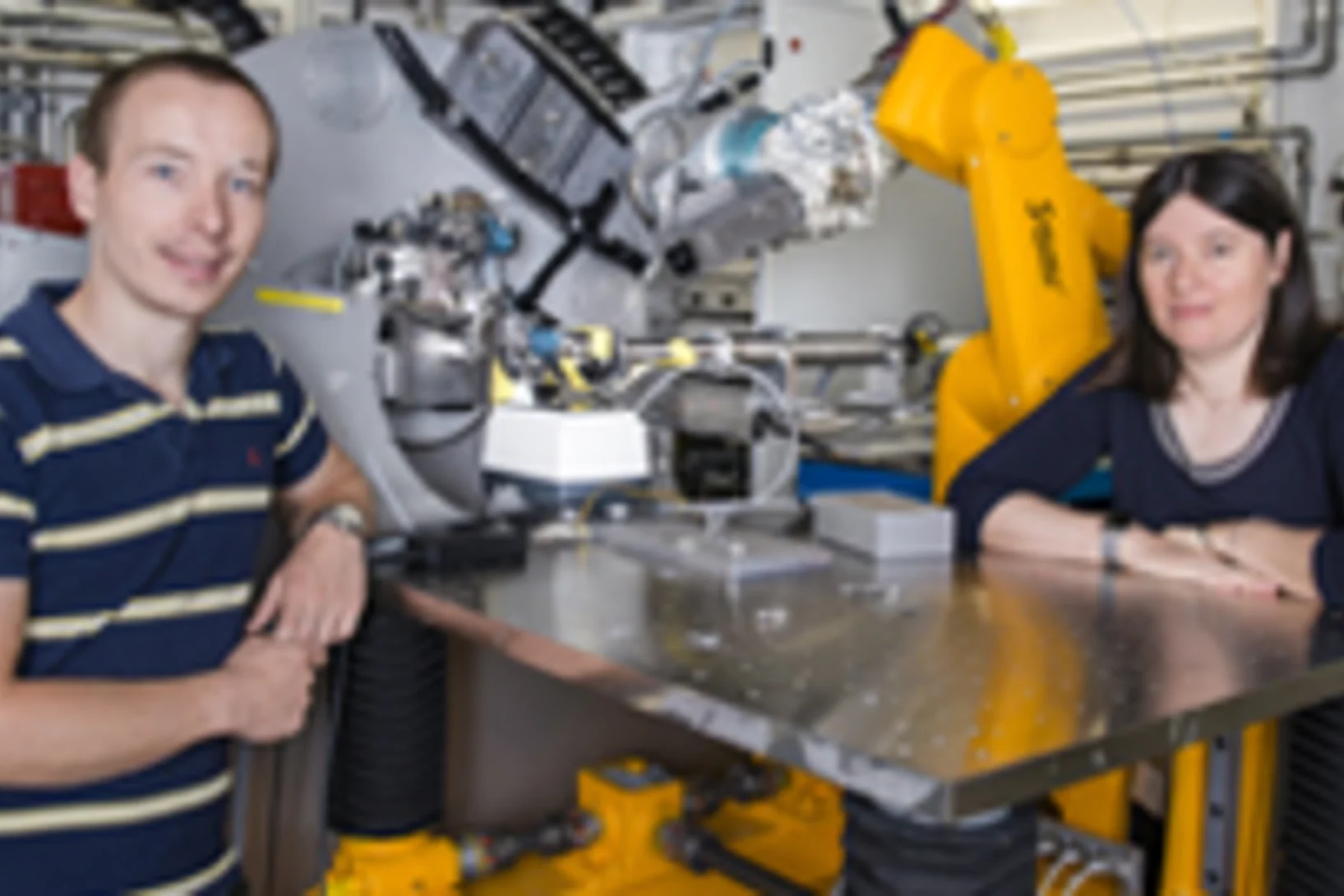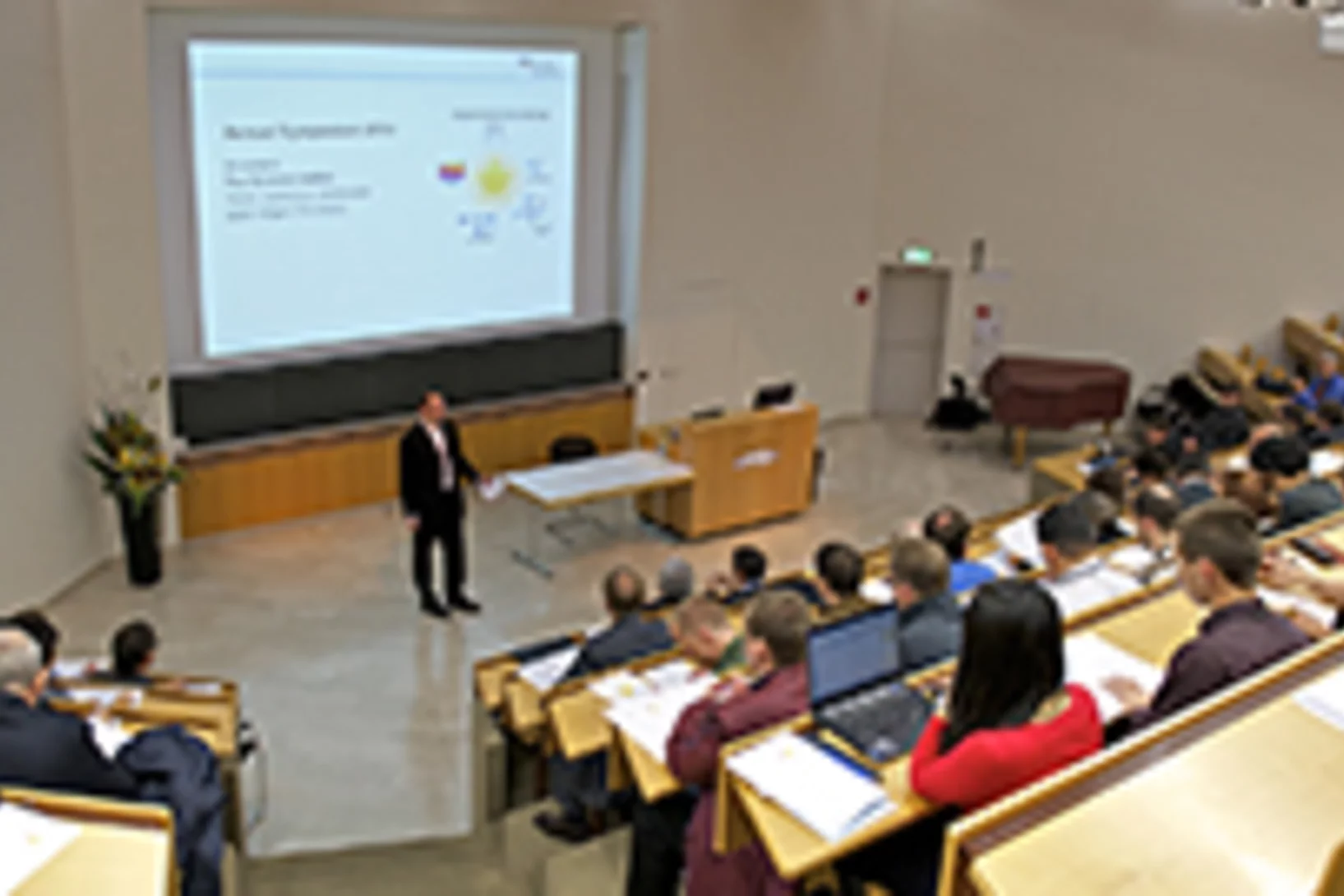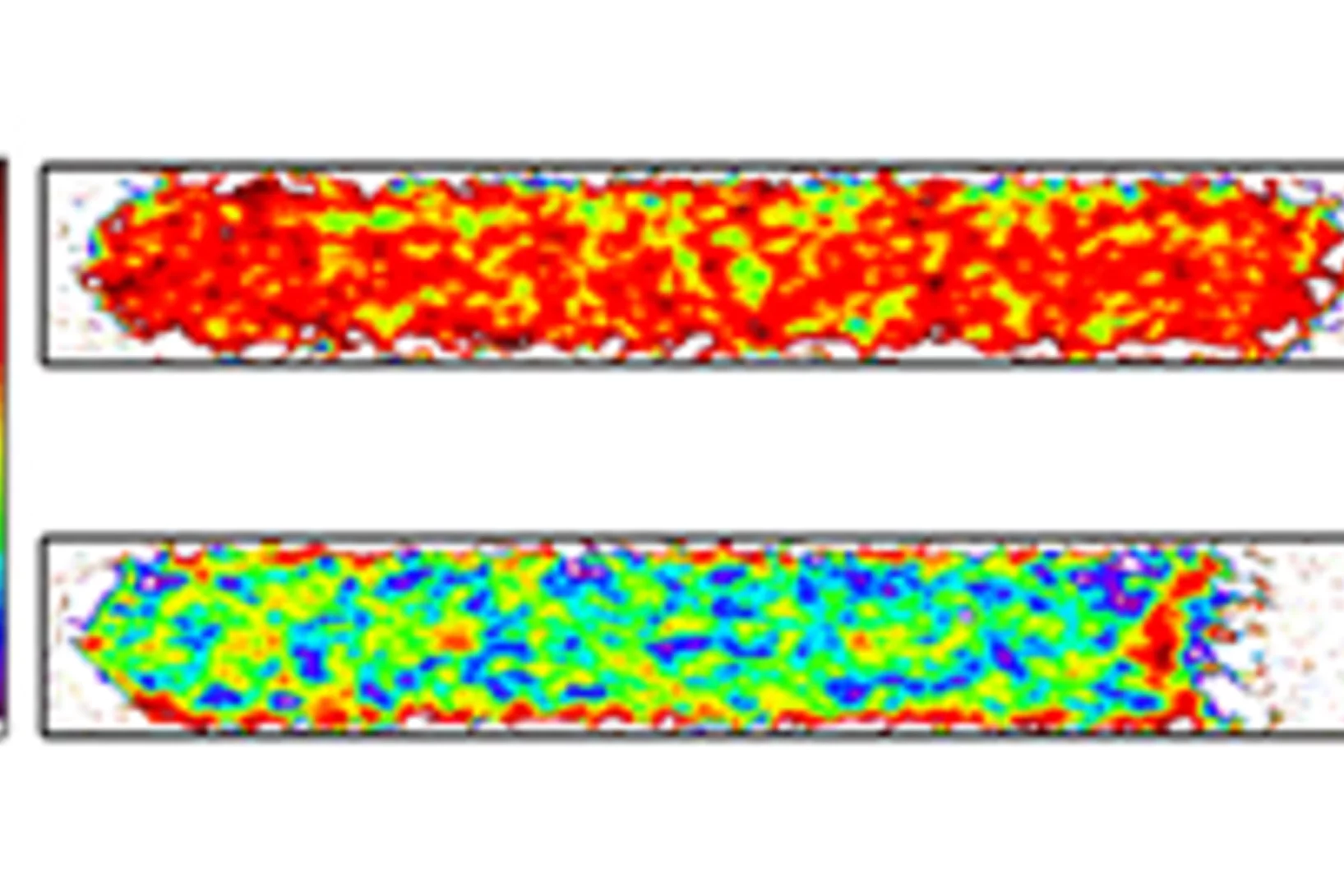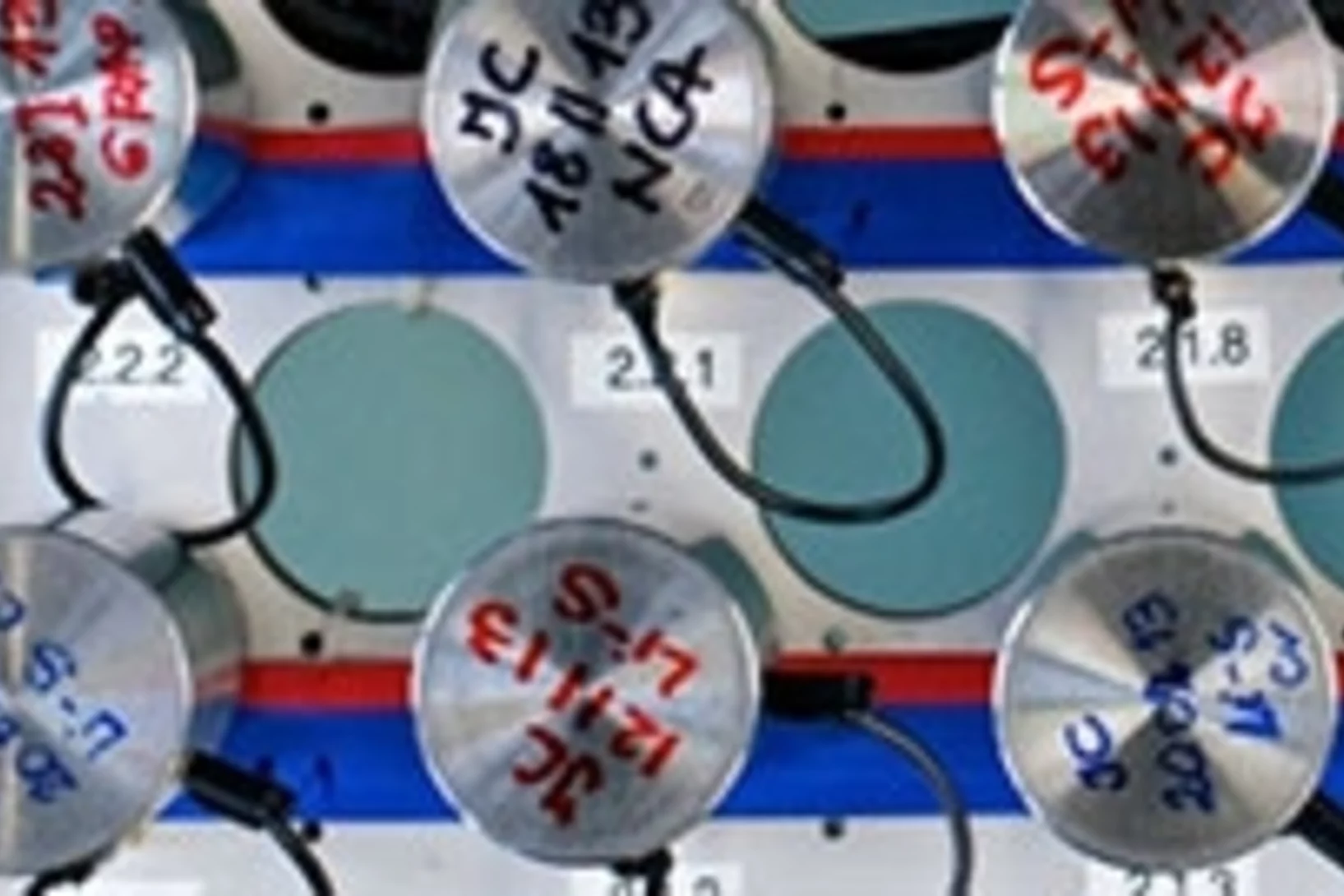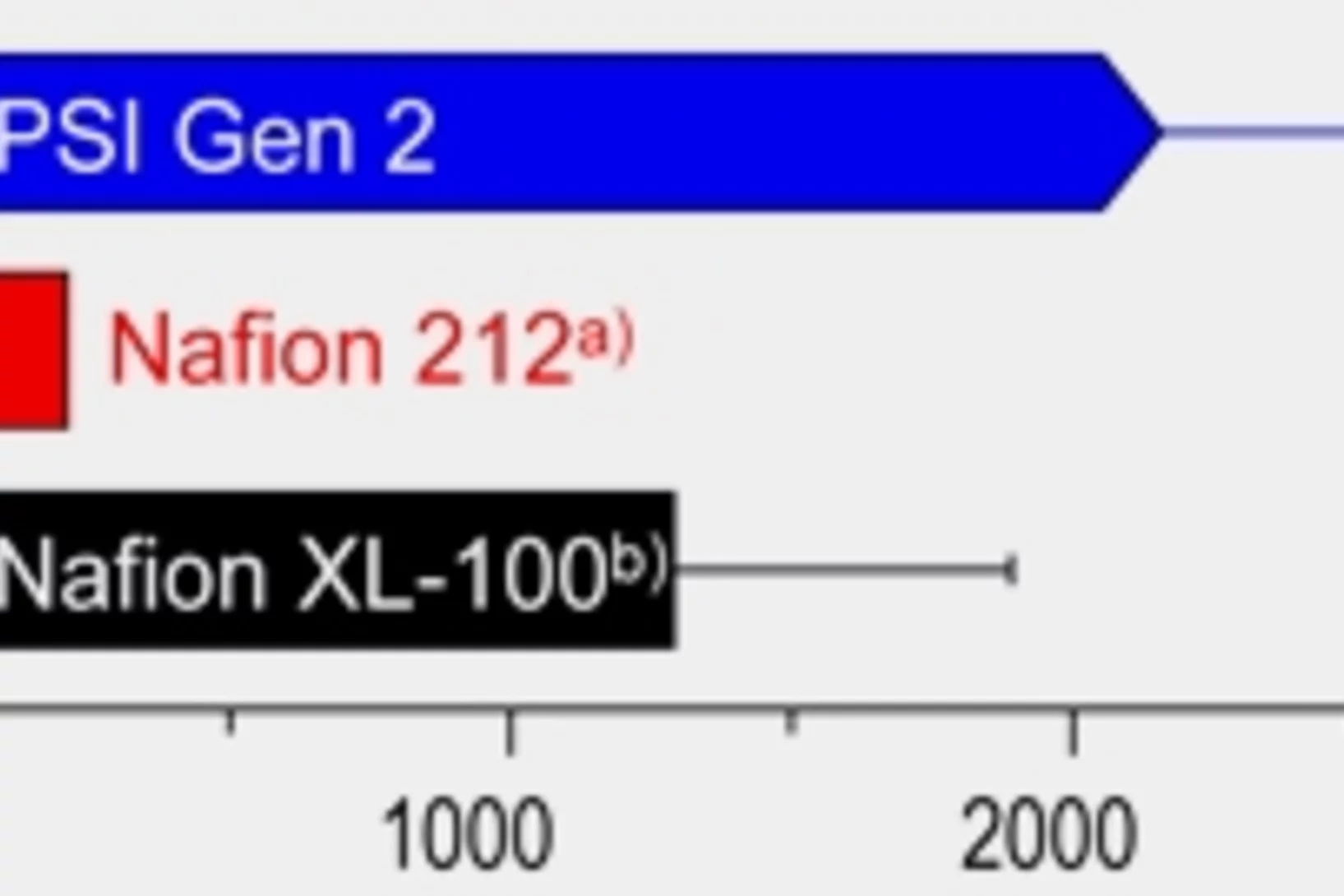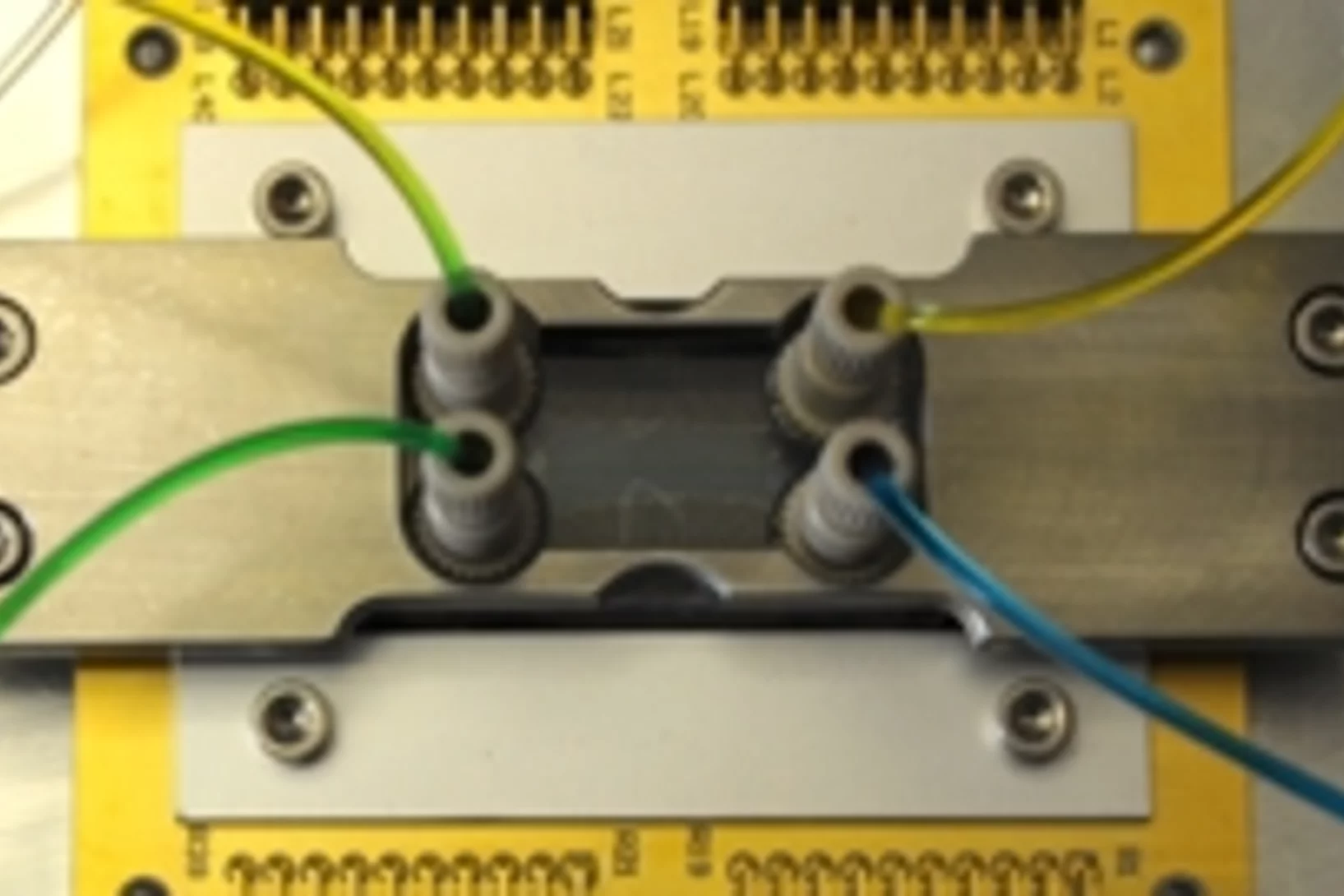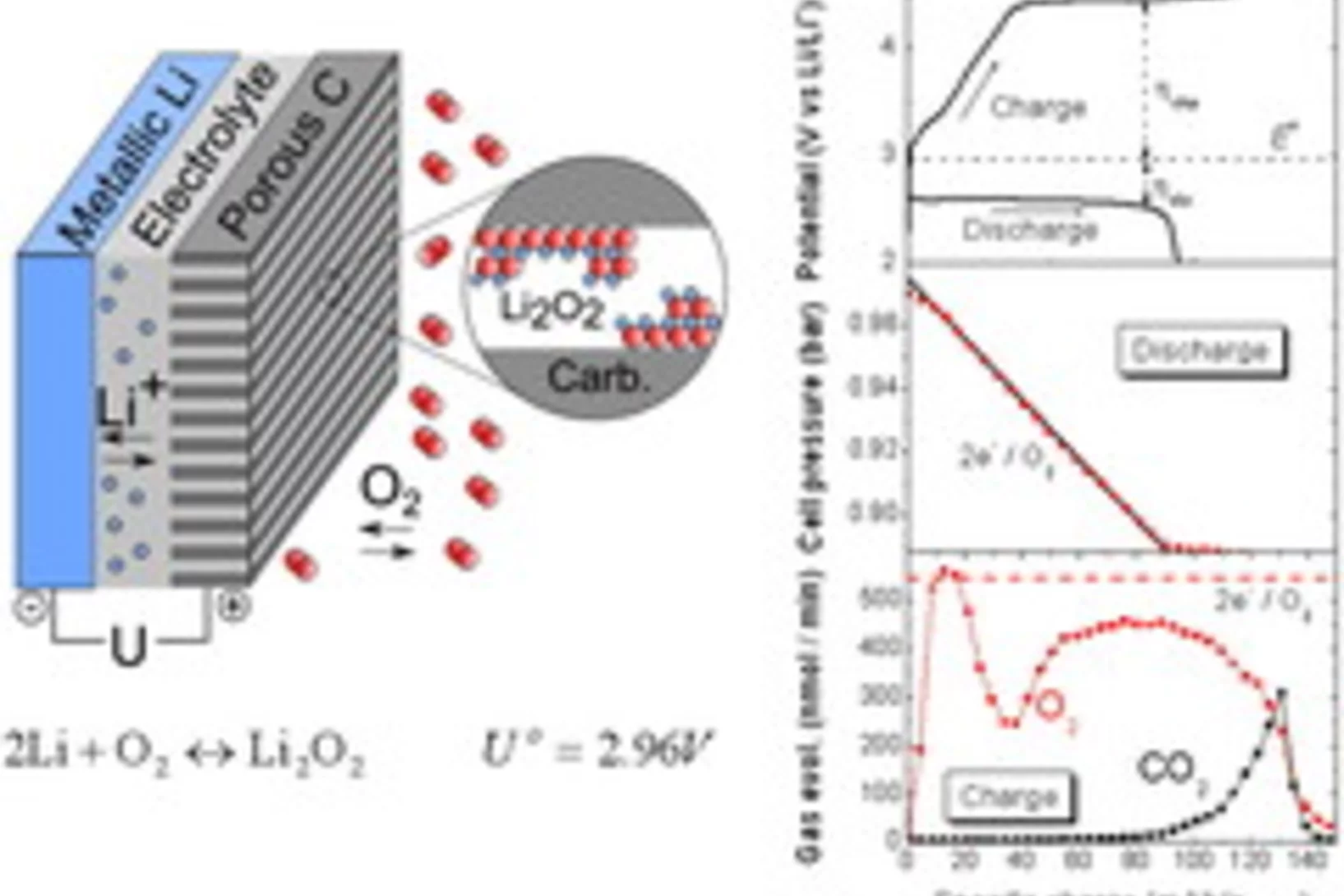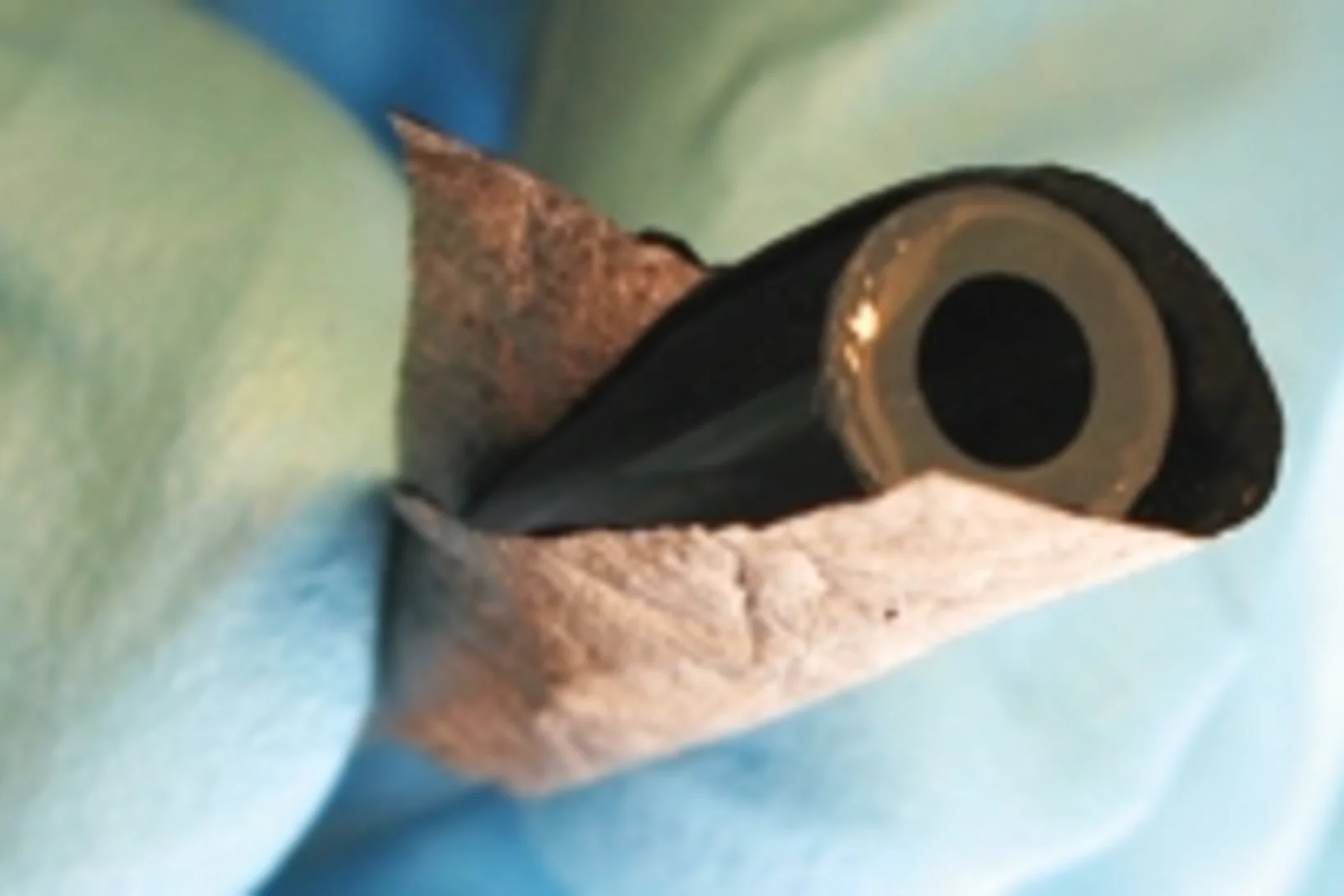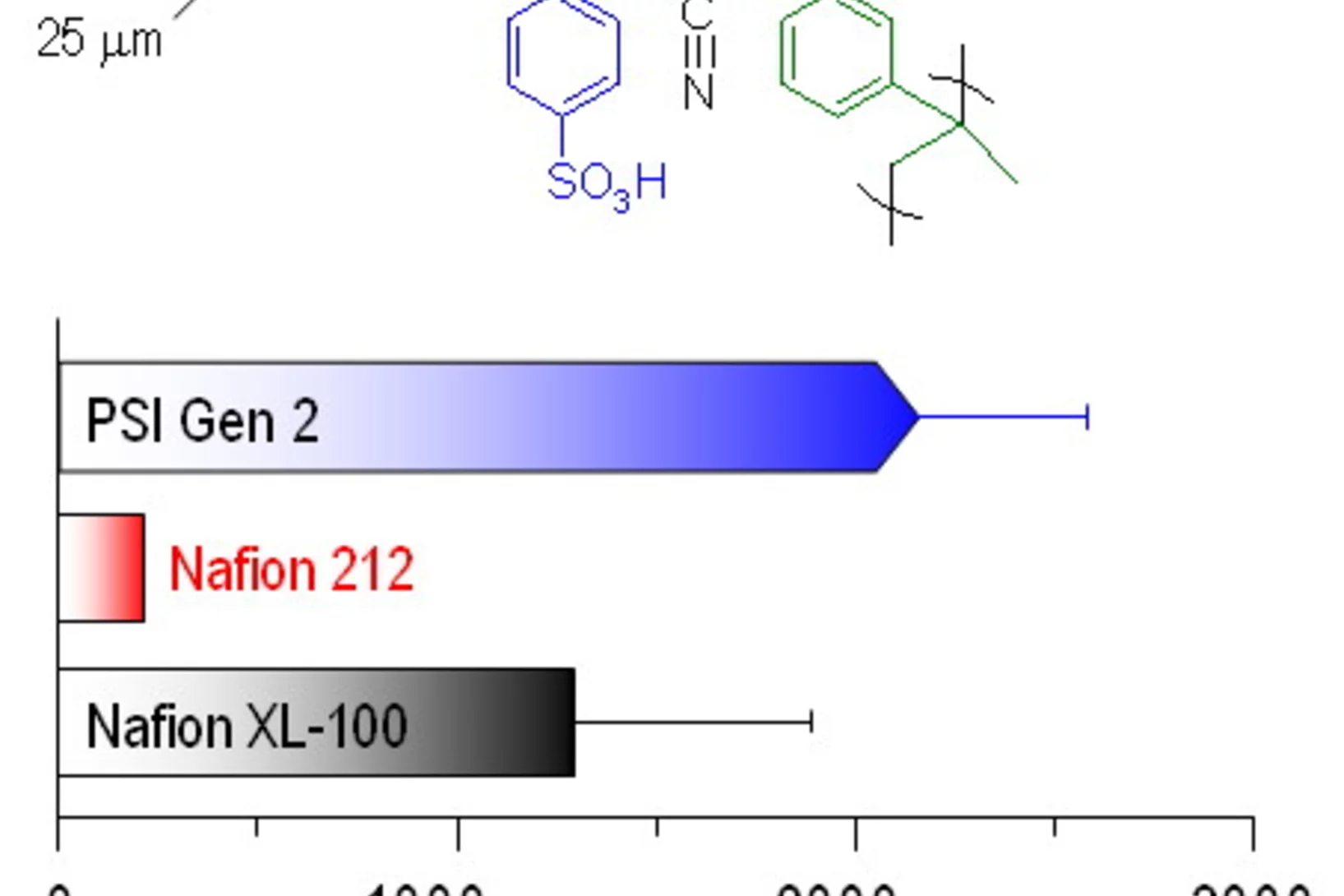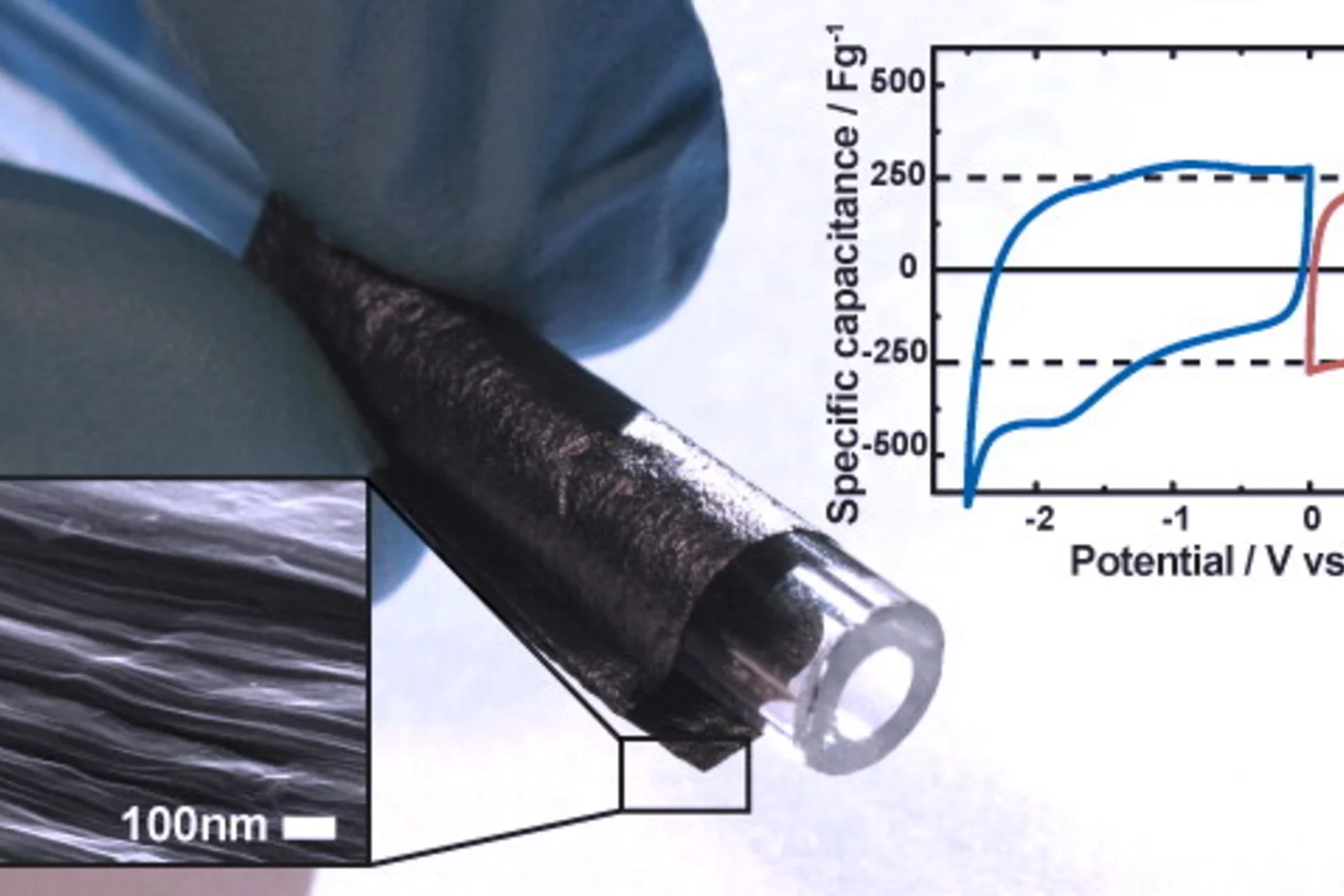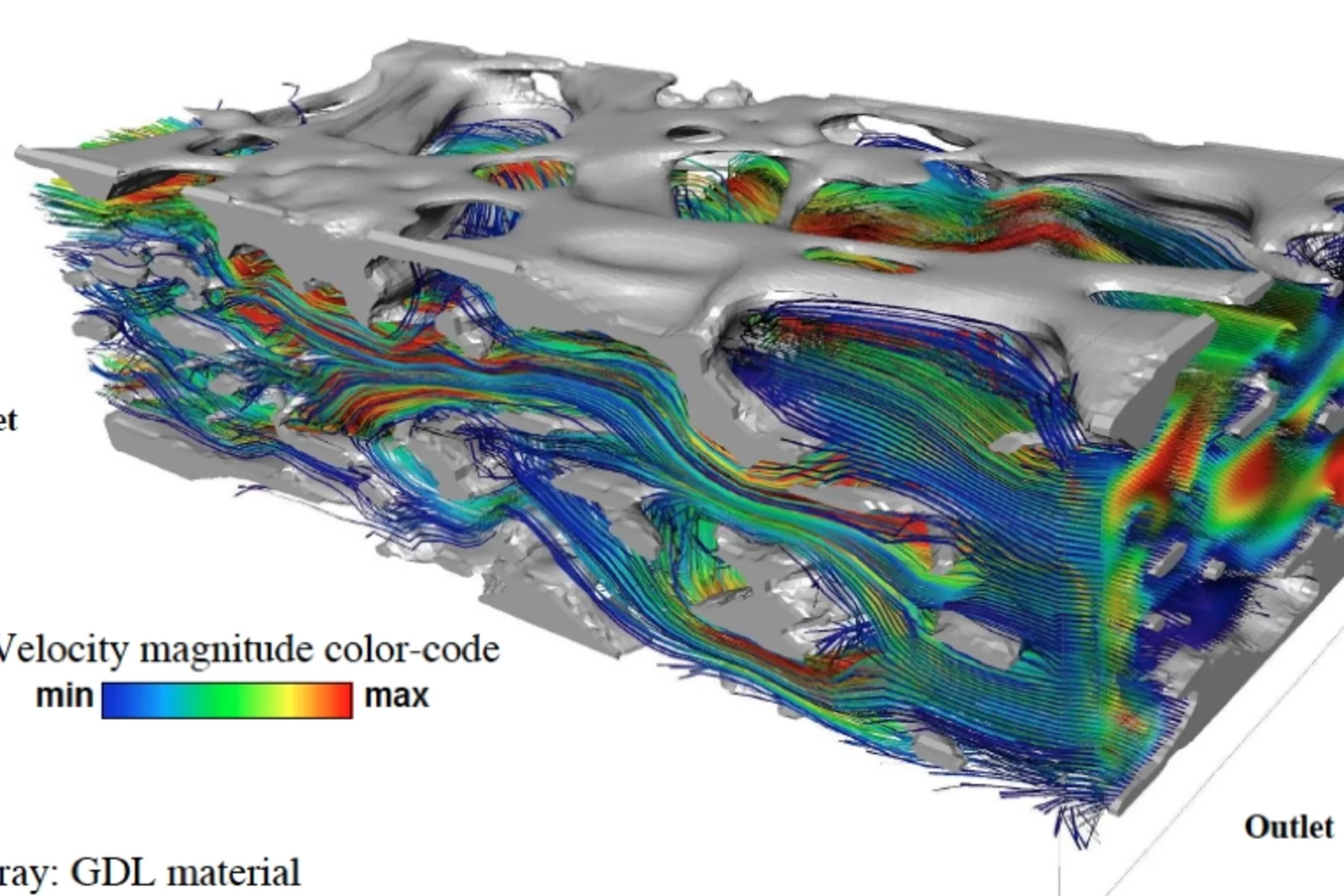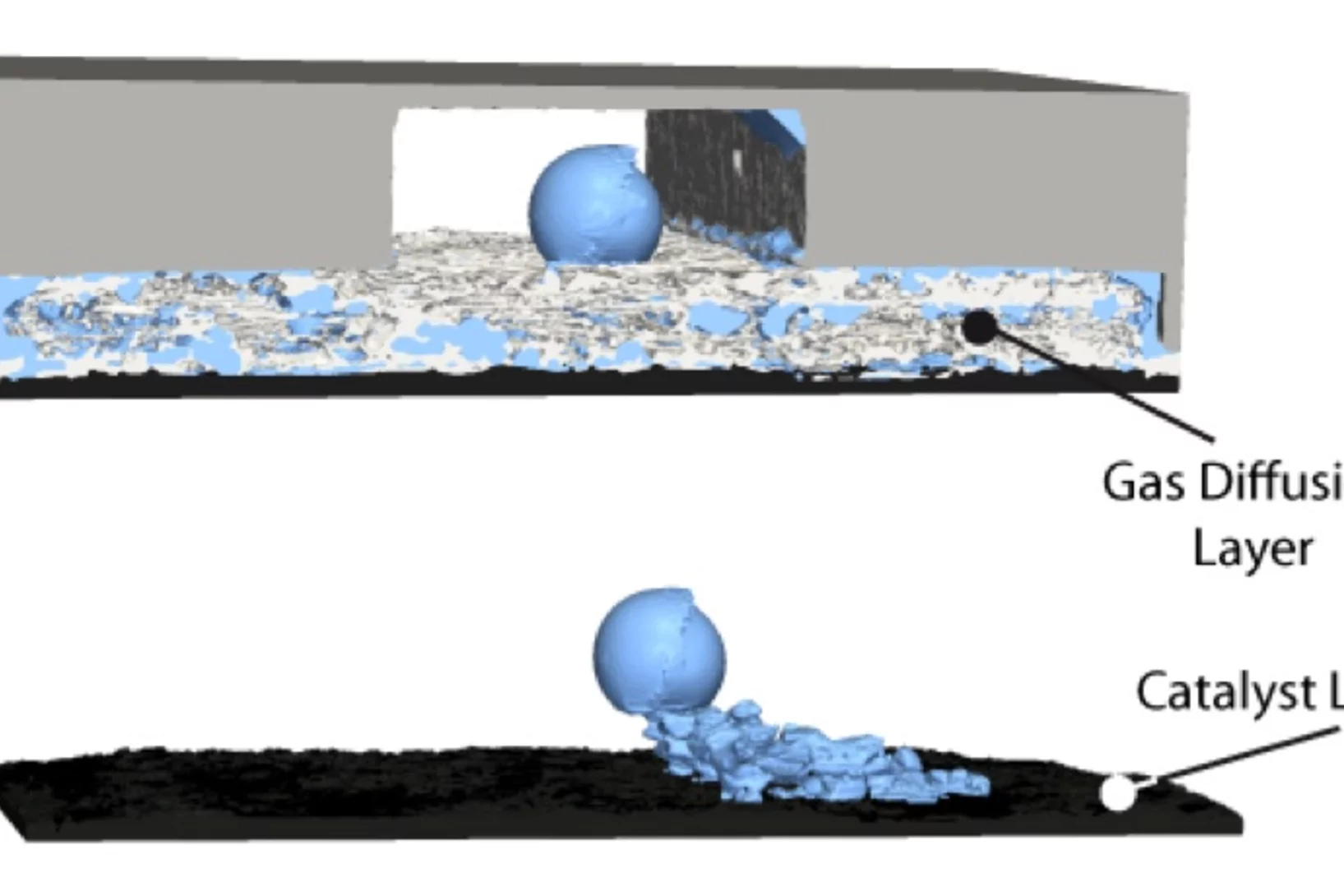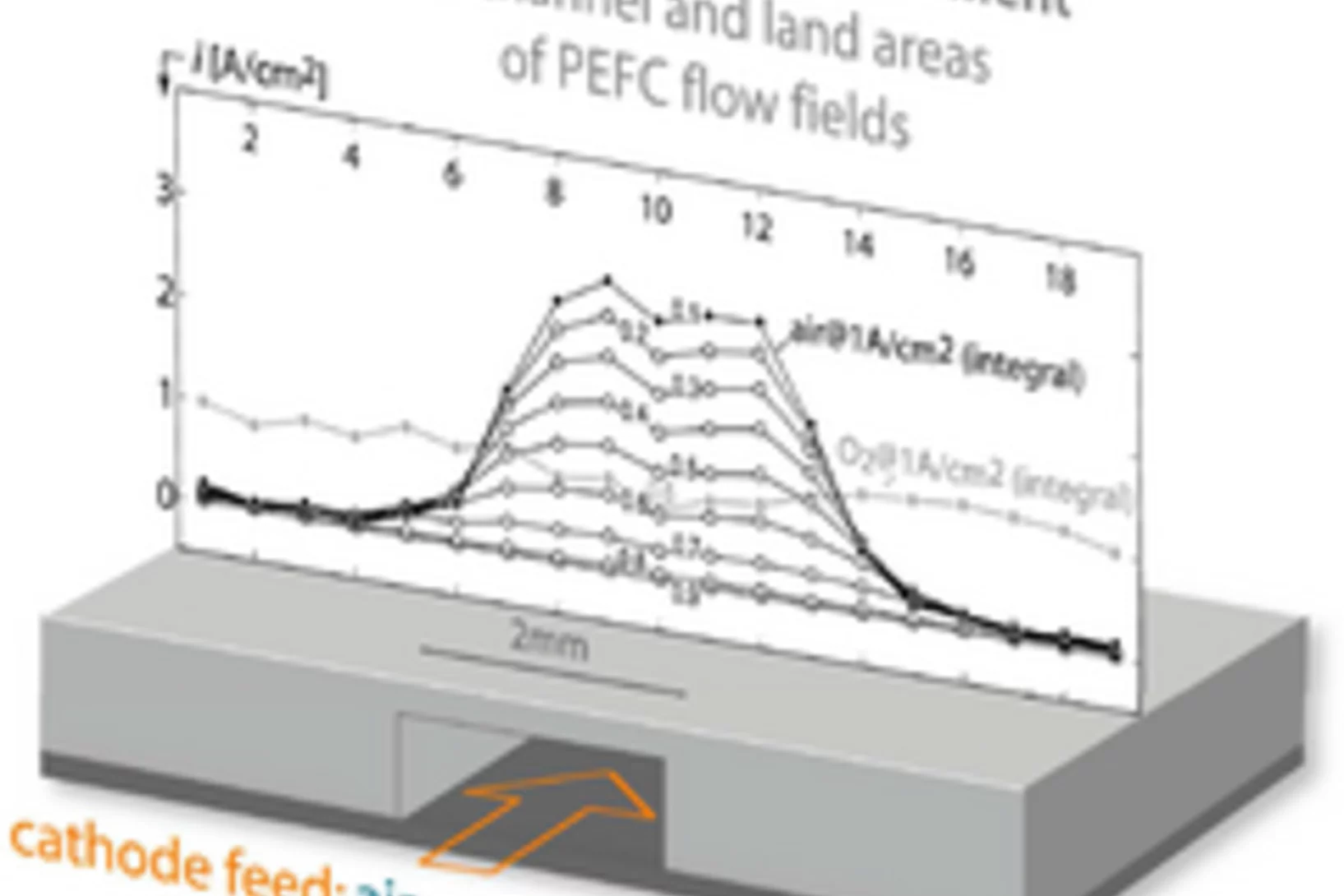Vom Walkman zum Elektroauto
Drei Forscher teilen sich dieses Jahr den Nobelpreis in Chemie. Sie werden ausgezeichnet für ihren jeweiligen Beitrag zur Entwicklung von Lithium-Ionen-Batterien. Petr Novák forscht am PSI ebenfalls in diesem Bereich und kennt die drei Preisträger seit Jahrzehnten persönlich. Im Interview erzählt er, wie er einem von ihnen im entscheidenden Moment gegenübersass.
Progress Towards Designed Membranes For All-Vanadium Redox Flow Batteries
Grid-scale storage of electricity is vital in energy scenarios with a high share of renewable electricity generation, such as wind and solar power. Redox flow batteries are particularly suited for intra-day time-shifting storage applications, yet investment costs need to be lowered for economic viability of the technology. We demonstrate a new ion conducting membrane that improves shortcomings of currently used materials and is potentially cheaper to produce.
Brennstoffzellen zum Durchbruch verhelfen
Wasserstoff gilt als vielversprechende Alternative für eine Zukunft ohne fossile Energieträger. Um Brennstoffzellen weiterzuentwickeln und für einen Markteintritt vorzubereiten, verstärkt die Empa die Zusammenarbeit mit der H2 Energy Holding AG und dem Paul Scherrer Institut (PSI).
Strom on demand
Produzieren Fotovoltaik- oder Windkraftanlagen mehr Strom, als das Netz aufnehmen kann, geht wertvolle Energie verloren. Auf der ESI-Plattform untersuchen Forschende des PSI, wie Brennstoffzellen dazu beitragen können, diese Energie durch Speicherung gezielt nutzbar zu machen.
Nanomaterial hilft Sonnenenergie zu speichern: effizient und kostengünstig
Damit Sonnen- und Windenergie in Form von Wasserstoff gespeichert werden können, werden effiziente Elektrolyseure benötigt. Dank eines neuen Materials, das Forschende des Paul Scherrer Instituts PSI und der Empa entwickelt haben, dürften diese Geräte in Zukunft günstiger und effizienter werden. Die Forschenden haben auch gezeigt, wie sich das neue Material zuverlässig in grossen Mengen herstellen lässt, und seine Leistungsfähigkeit in einer technischen Elektrolysezelle, der Hauptkomponente eines Elektrolyseurs, nachgewiesen.
Next Generation Catalysts for Polymer Electrolyte Fuel Cells
Electric vehicles powered by hydrogen polymer electrolyte fuel cells are one option to move towards a low emission transport sector. To decrease the cost of such devices, further research on the various fuel cell components is pursued in academia in industry.
Quarzpulver für den Akku der Zukunft
Materialforschende des PSI haben eine Methode entwickelt, die entscheidende Einblicke in die Lade- und Entladeprozesse von Lithium-Schwefel-Akkus ermöglichen. Die Methode offenbarte zudem: Mit Quarzpulver als Akku-Zusatz steigt die darin verfügbare Energie und der allmählich eintretende Kapazitätsverlust fällt deutlich schwächer aus.
So halten Akkus länger und laden schneller
Forschende des PSI und der ETH Zürich haben ein sehr einfaches und kostengünstiges Verfahren entwickelt, um die Leistung herkömmlicher Lithium-Ionen-Akkus deutlich zu steigern. Ob Armbanduhr, Smartphone, Laptop oder Auto, für alle Anwendungsbereiche lassen sich so die Akkus optimieren. Demnach hält eine Ladung nicht nur deutlich länger, auch das Aufladen erfolgt schneller.
Wasserkanäle machen Brennstoffzellen effizienter
Forschende des Paul Scherrer Instituts PSI haben im Labor ein Beschichtungsverfahren entwickelt, das die Effizienz von Brennstoffzellen erhöhen könnte. Das für die Massenproduktion geeignete Verfahren haben die PSI-Wissenschaftler bereits zum Patent angemeldet.
Der Schlüssel für schnelles Aufladen einer Lithiumionen-Batterie
Lithiumeisenphosphat-Batterien sind sehr langlebig und lassen sich relativ schnell aufladen. Forschende des Paul Scherrer Instituts PSI, der ETH Zürich und der Forschungs- und Entwicklungslabore von Toyota zeigen in einer neuen Studie die Gründe für diese Eigenschaften. Die Erkenntnisse wurden möglich dank Messungen mit einer neuen Methode an der Synchrotron Lichtquelle Schweiz SLS des PSI.
Das Kompetenzzentrum Speicherung zieht nach einem Jahr Bilanz
Am vergangenen 4. November fand am Paul Scherrer Institut das erste Jahressymposium des Kompetenzzentrum des Bundes für Forschung zu Strom- und Wärmespeicherung (SCCER Heat and Electricity Storage) statt. Vertreter aus den beteiligten Forschungsgruppen sowie aus Industrieunternehmen mit einem Bezug zum Thema Speicherung berichteten in ihren Vorträgen über die jüngsten Fortschritte auf dem Gebiet der Wärme- und Stromspeicherung in der Schweiz. Die Tagung zeigte die Intensität der Transformationen, die von der Energiestrategie 2050 in Gang gesetzt worden sind.
Eis in Brennstoffzellen erstmals direkt sichtbar gemacht
Forscher des Paul Scherrer Instituts PSI haben mit Hilfe einer neuartigen Methode erstmals die Verteilung von Eis und flüssigem Wasser in einer Wasserstoff-Brennstoffzelle direkt abgebildet. Die neue Bildgebungstechnik verwendet zwei Strahlen mit unterschiedlicher Neutronenenergie, um Bereiche mit flüssigem Wasser von solchen mit Eis mit hoher Zuverlässigkeit zu unterscheiden. Die Methode eröffnet somit die Perspektive, eines der wichtigsten Probleme bei der Anwendung von Brennstoffzellen als Antrieb von Fahrzeugen zu untersuchen. Eis kann nämlich die Poren in den Brennstoffzellen verstopfen und dadurch ihre Funktion beeinträchtigen. Ihre Ergebnisse veröffentlichen die PSI-Wissenschaftler am 16.6.2014 im Journal Physical Review Letters.
Brennstoffzellen-Knowhow aus dem Paul Scherrer Institut im Herz der neuen SBB-Minibars
Die SBB lanciert am 4. April 2014 ein neues Minibar-Modell in ihren Intercity-Zügen. Mit an Bord wird dann ein vom Paul Scherrer Institut mitentwickeltes Brennstoffzellen-System sein. Es sorgt dafür, dass die Minibar nun trotz Platzbeschränkungen über genügend Kraft verfügt, um auch Capuccinos und Latte macchiato zu brühen.
Das Paul Scherrer Institut leitet zwei der Energie-Kompetenzzentren des Bundes
Als Bestandteil der Energiestrategie 2050 haben Bund und Parlament eine verstärkte Förderung der Energieforschung in der Schweiz beschlossen. Dazu gehört die Einrichtung von sieben interuniversitär vernetzten Kompentenzzentren (Swiss Competence Centers in Energy Research SCCER). In den SCCER sollen sich Institutionen aus dem ETH-Bereich, den Universitäten und den Fachhochschulen gemeinsam mit Industriepartnern zusammenschliessen, um neue Kompetenzen und Lösungen in für die Energiewende entscheidenden Aktionsfeldern zu erarbeiten. In zwei SCCER à zu den Themen Speicherung und Biomasse à, die bereits den Zuschlag erhalten haben, ist das Paul Scherrer Institut PSI die federführende Institution. Die beiden Kompetenzzentren werden ihre Arbeit im Jahr 2014 aufnehmen.
Brennstoffzellenmembran aus dem Paul Scherrer Institut besser als kommerzielle Pendants
Eine neuartige Polymermembran aus dem Paul Scherrer Institut PSI hat im Labortest eine längere Haltbarkeit als die besten kommerziell erhältlichen Pendants gezeigt. Der Durchbruch gelang dank Modifizierung eines preisgünstigen Kunststofffilmes durch Bestrahlung und anschliessendes Aufpfropfen funktioneller Komponenten. Der so veränderte Kunststoff hält nicht nur lange à er könnte die Herstellungskosten der Membran um 50 bis 80 Prozent senken. Anwendung finden könnte die Membran etwa in Wasserstoffbrennstoffzellen oder in Elektrolyseuren zur Wasserstoffherstellung aus Wasser.
Zukünftige Computerchips mit "elektronischem Blutkreislauf"
Im Rahmen des Sinergia-Programms fördert der Schweizerische Nationalfonds das dreijährige Forschungsvorhaben REPCOOL. Unter der Leitung von IBM Research à Zürich arbeiten in diesem Projekt Wissenschaftler der ETH Zürich, des Paul Scherrer Instituts in Villigen und der Università della Svizzera italiana in Lugano gemeinsam an der Erforschung eines elektronischen Blutkreislaufs für zukünftige 3D-Computerchips. Vom menschlichen Gehirn inspiriert, entwickeln die Forscher ein Mikrokanalsystem mit einer elektrochemischen Flussbatterie, die 3D-Chipstapel gleichzeitig kühlen und mit Energie versorgen. Ultimatives Ziel ist die Entwicklung eines Supercomputers in PC-Grösse.
Fünfmal weniger Platin: Brennstoffzellen könnten dank neuem Aerogel-Katalysator wirtschaftlich attraktiver werden
Wasserstoff-Brennstoffzellen haben das Potenzial, die individuelle Mobilität in eine umweltfreundliche Zukunft zu führen. Das Paul Scherrer Institut PSI erforscht und entwickelt seit mehr als 10 Jahren solche Brennstoffzellen. Erste Praxistests haben deren erfolgreichen Einsatz in Autos und Bussen demonstriert. Weitere Forschung bleibt jedoch nötig, um ihre Langlebigkeit und Wirtschaftlichkeit zu verbessern. Ein internationales Forscherteam mit PSI-Beteiligung hat nun ein neues Nanomaterial hergestellt und charakterisiert, das Leistungsfähigkeit und Haltbarkeit dieser Brennstoffzellen um ein Vielfaches erhöhen könnte - bei gleichzeitiger Senkung der Materialkosten.
Dosing Differential Electrochemical Mass Spectrometry (D-DEMS) for Li-O2 Batteries
The high-energy rechargeable Li-O2 battery has been subject to intensive research worldwide during the past years. The Li-O2 cell mainly comprises a negative (e.g. Li metal) and positive (e.g. porous carbon) electrode separated by an electronically insulating, but Li+ conducting electrolyte layer. In order to study the cell chemistry, a differential electrochemical mass spectrometry setup based on a set of valves, a pressure sensor and a quadrupole mass spectrometer has been developed.
Ein hauchdünner Speicher aus Kohlenstoff
Für die Entdeckung und Charakterisierung des Wundermaterials Graphen à eine genau 1 Atom dünne Schicht aus Kohlenstoff à erhielten zwei russischstämmige Physiker im Jahr 2010 den Nobelpreis und viel Medienrummel. Seit der ersten Isolierung von Graphen stürzten sich deshalb weltweit Wissenschaftler auf die Suche nach Anwendungen. Forscher am Paul Scherrer Institut PSI haben nun die Grundlagen für einen Graphen-basierten Superkondensator erarbeitet. Mit dessen Hilfe liesse sich etwa die Lebensdauer von Batterien in Hybridautos deutlich verlängern.
Radiation grafted membranes developed at PSI outlast state-of-the art commercial membranes in the fuel cell
Components for the polymer electrolyte fuel cell (PEFC) are required to show high performance and durability under application relevant conditions. Furthermore, for commercial viability the materials and processes for component fabrication need to be of los cost. The polymer electrolyte membrane developed at PSI on the basis of the radiation grafting technique has the potential of being produced in cost-effective manner. In recent years, we have collaborated with the Belenos Clean Power to further develop the membrane to commercial competitiveness.
Memory-Effekt nun auch bei Lithiumionen-Batterien nachgewiesen
Lithiumionen-Batterien dienen als leistungsstarke Energiespeicher in vielen kommerziellen Elektronikgeräten. Sie können viel Energie auf kleinem Raum und bei relativ geringem Gewicht fassen, so viel steht fest. Zudem eilt ihnen der gute Ruf voraus, keinen Memory-Effekt aufzuweisen. Darunter verstehen Fachleute eine Abweichung der Arbeitsspannung der Batterie, die bei unvollständigem Laden bzw. Entladen auftritt und dazu führen kann, dass die gespeicherte Energie nur teilweise nutzbar und der Ladezustand der Batterie nicht zuverlässig abzuschätzen ist. Forscher des Paul Scherrer Instituts PSI haben nun, zusammen mit Kollegen des Toyota-Forschungslabors in Japan, bei einem weit verbreiteten Typ der Lithiumionen-Batterie doch einen Memory-Effekt entdeckt. Besonders hohe Relevanz besitzt der Fund im Hinblick auf den bevorstehenden Einzug der Lithiumionen-Batterien in den Elektromobilitätsmarkt. Die Arbeit erschien heute in der Fachzeitschrift Nature Materials
Partially reduced graphene oxide paper: a thin film electrode for electrochemical capacitors
One way to utilize graphene and its’ outstanding specific surface area of 2630 m2g-1 for supercapacitor electrodes is by preparing a so called free-standing graphene paper. Such a flexible, conductive graphene-paper electrode was prepared by a flow-directed filtration of graphene oxide dispersion followed by a gentle thermal reduction treatment of the filtrate. The prepared partially reduced graphene oxide paper (GOPpr) showed a dense packing of graphene sheets with a distinct interlayer distance of 4.35 Å.
Flow modeling in gas diffusion layers of PEFCs at the micro- and mesoscale
he optimization of thermochemical and electrochemical conversion systems is of high importance for a sustainable energy future society. Of particular interest regarding the performance of polymer electrolyte fuel cells (PEFCs) is the study of the gas flow in the gas diffusion layers (GDL). More specifically, permeability and diffusivity measurements in a model PEFC under normal operating conditions are highly desirable. As laboratory-measurements of these quantities under such conditions are very demanding, an alternative is the use of computer-based simulations.
X-Ray Tomography of Water in Operating Fuel Cell
Polymer electrolyte fuel cells (PEFC) convert the chemical energy of hydrogen with a high efficiency (40-70 %) directly into electricity. The product of the overall reaction is water, produced at the cathode of the cell. The interaction of liquid water with the porous structures of the cell is one of the mechanisms in the PEFC that are commonly believed to be key for further optimization with regard to performance, durability and cost.
Local current measurement in PEFC
Major barriers for a successful commercialization of Polymer Electrolyte Fuel Cells (PEFCs) are insufficient lifetime and high cost of platinum catalyst. A comprehensive understanding of aging and transport phenomena on all relevant length scales is a key to improve durability and to reduce precious metal loading. Flow fields as used in PEFCs for the distribution of the reactant gases over the electrode area cause inhomogeneities. The importance of down the channel inhomogeneities has been realized.


